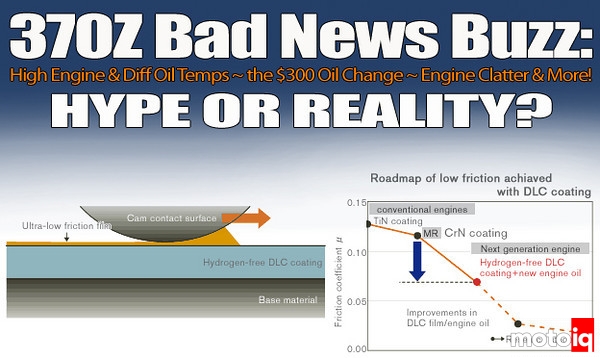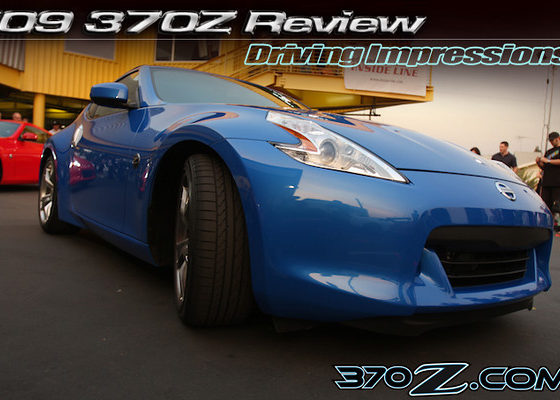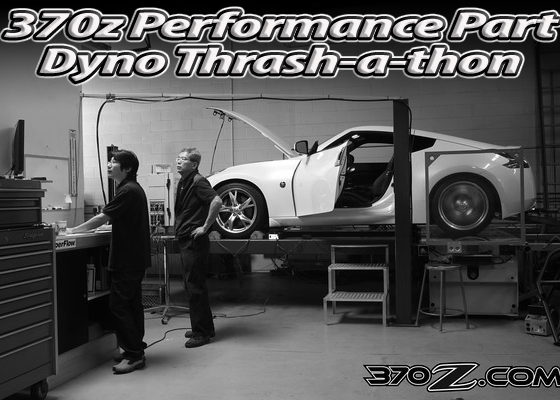,
The conversations on oil temperature issues leads to Nissans recommendations for Genuine Nissan “ester” based oil and the super expensive oil service. Posts on forums indicate that some Nissan dealers are charging up to $300 for an oil change for the special oil that is mandatory for use on the 370Z. Is this oil expensive? Yes, does it have significant value? Yes, is it mandatory for your warranty or to insure long engine life? No. Is it important if you are the type of driver that wants the best for your engine in terms of fuel economy, life and performance? Yes. Is the “special” oil market hype intended to enrich Nissans coffers? It’s up to you to decide, we will attempt to explain whats going on with the oil so you can decide for yourself.
 |
| Standard DLC coating is very slippery and reduces friction considerably but does not attract oil |
Nissans oil was developed in a push to greatly reduce friction in an engines valvetrain. The valve train is the second biggest contributor to the total amount of an engines mechanical friction, the piston rings being the biggest contributor. Usually on most engines the valvetrain produces 15-20% of the total friction of an engine. An engine with a complicated valvetrain like the VQ37VHR is probably on the high end of this figure. Nissans special oil and their newly developed hydrogen free DLC coating on cam followers reduces the amount of friction produced by the valve train by a huge amount This can make a considerable difference in fuel economy and power output.
What is Nissans special oil? The oil was developed to complement Nissans Hydrogen free DLC coating used on the cam followers in the QR25DE engine, the VQ35HR and the VQ37VHR engines. DLC stands for diamond like coating, which is an amorphous layer of carbon crystals with hard smooth properties much like diamond. Most of valve train friction is created by the interface between the cam follower and the cam lobe. DLC is very slippery stuff and Nissan uses it to reduce valvetrain friction to improve fuel economy, reduce emission and increase power.
 |
| Nissan's hydrogen free DLC coating has a strong molecular attraction towards Nissan's special nano particle ester oil. This reduces friction to unheard of levels |
Nissan figured that eliminating the hydrogen molecules in the DLC coating would make it an attractor of polar molecules like those found in hydroxyl compounds. A hydroxyl molecule is highly polar hydrocarbon molecule. The polarity makes it a good solvent so it mixes well with other fluids, like oil. Nissan chose ester hydroxyls, part of the alcohol family, probably because the properties of esters in motor oil are well understood as esters have been used as friction modifiers in motor oil for decades. Nissan chose an ester called PAO an ester often found as a friction modifier in oil. By adding PAO so it would be around 10-15% of the oil, when combined with the hydrogen free DLC coating, Nissan created oil that would be attracted to the cam follower on a molecular level.
In studying the various technical white papers and patents for Nissan’s super oil, we are not exactly sure of its exact composition in terms if its is considered a synthetic or not. Nissans patents and technical documentation are very broad when describing the make up of the super oil, probably to protect against patent infringement and to make it hard for a competitor to make the exact same stuff. We can ascertain that the technology is compatible to most known base oils, be they synthetic, mineral or a blend and we do know that esters are synthetic compounds so at least the oil is probably considered a semi synthetic at the least. The Nissan oils bottle lable says petroleum oil under contents, a bottle of Mobile One doesn’t say this. The Nissan oil smells like ester oil use in AC systems.
The next unusual thing about Nissans oil is its innovative use of nano technology. To help lubricate areas of extreme pressure and friction in the engine, the biggest of which is the interface between the cam lobe and cam follower, engine oils have traditional used what are called extreme pressure friction modifiers. These typically are compounds that have a slight molecular attraction to metal and usually have a slippery metallic element to them. These are compounds such as zinc diphosphate, molybdenum dithiophosphate and molybdenum dithiocarbamate. These friction modifiers work pretty well for preventing metal to metal contact in an engine but they have some issues. One is that they don’t burn completely when they get past the piston rings and valve guide seals and create ash; this can end up being a hard but sticky deposit in your engine’s combustion chamber and valves that can stick rings and valves, raise compression to cause detonation, and create porous hydrocarbon traps in the combustion chambers, valve and ports that screw up emissions and reduce flow, hurting power. These chemicals can also contaminate catalytic converters making them lose their effectiveness. These friction modifiers also are prone to shearing down and wearing out over time, losing their effectiveness.
Nissan, in their search for improving oils frictional properties, figured out a way to substitute ultra hard nano particles for the normal chemical friction modifiers adding some interesting molecular twists. Again due to the convoluted nature of Nissan’s white papers and patents, its hard to guess exactly what the nano particles are but they are defiantly an ultra hard industrial abrasive or bearing type ceramic and probably at least in part, nano particles of industrial diamond!
 |
| Nissan's hydrogen free DLC coating uses molecular attraction and the bearing action of likely attracted nano particles to reduce friction to previously unheard of levels, Nissan's treatment is significantly slicker than super slick coatings like titanium nitrate and standard DLC coating as shown in this chart |
Why would Nissan put abrasives or chunks of bearing material in its oil? Well you have to consider some things about nano technology. The unit of measure here is called a nanometer or one billionth of a meter, that’s pretty darned small. A nanometer sized particle is much too small to be seen by the naked eye. For instance a water molecule is somewhat less than one nanometer. A typical bacterium is just less than 1000 nanometers and a hair is 100,000 nanometers thick. In the world of physics, weird things happen when particles are this small. The particles of the diamond/ceramic are so small they mix with the oil and stay suspended as they are hardly affected by gravity and molecular forces called van der waals forces keep them apart. They also are undetectable to the naked eye and the oil still looks clear.
Nissans super oil is around 0.5% nano particles by weight. The particles are probably around 10 nanometers in diameter, really very small! A certain percentage of the nano particles have to be carbon based, preferably single crystal synthetic diamond. The carbon content helps make the nano particles attracted to the low hydrogen DLC coating. Instead of making a slippery metallic film on bare metal parts like traditional friction modifiers, the nano particles act like atomic level miniature ball bearings, preventing metal to metal contact and reducing friction to previously unheard of levels. These nano particles are ashless if they find there way into the engine, making the oil low deposit forming for lower emissions. The Nissan super oil does most of its friction reduction in the valvetrain but it still helps in other parts of the engine, particularly in areas were metal to metal contact might occur.
 |
| Nissan's ester nano particle oil reduces friction in these parts of the engine as well, wherever there is the potential for metal to metal contact, it will help |
In lab testing of test coupons, the Nissan Super oil with hydrogen free DLC coating had the friction reduced by 60-75 percent over conventional oil with no coating. This equated to a around a 40% reduction in total valvetrain friction in a real motor and a 20-25% reduction in total friction of the motor! This is a significant result which should show real gains in fuel economy and probably something like 1-1.5 hp per cylinder at high rpm over an uncoated valvetrain with conventional oil. If this is worth something to you then yes, the expense of the oil is worth it! Now the DLC coating still works at reducing friction with regular oil just not as amazingly well. Not using the Super oil will not cause you engine to wear out prematurely or anything like that but it probably will wear slightly more, particularly in the valve train, probably at a level that doesn’t matter much.
 |
| Nissan's nano particle oil when combined with low hydrogen DLC coating reduces total engine friction by 25%. This helps fuel economy, reduces emissions and help free up several horsepower in the 370Z and G37. The QR25DE engine used in the Sentra SE-R Spec-V and Altima, The Maxima, and the FX56 all use this technology |



